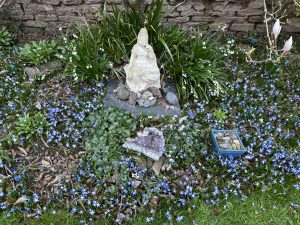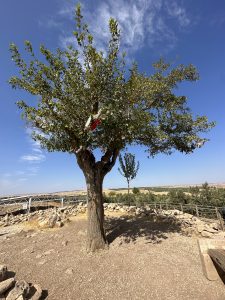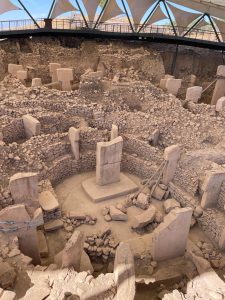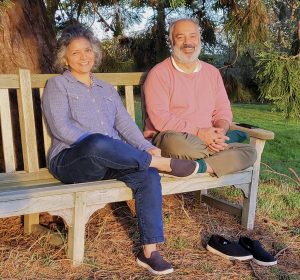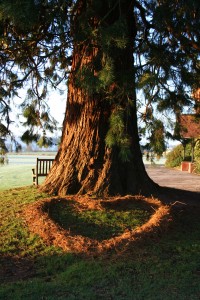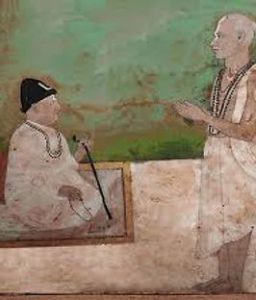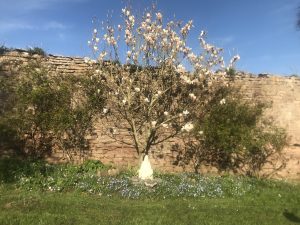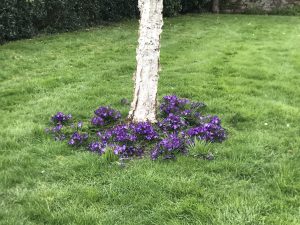About 10 years ago, whilst visiting Varanasi, one of the main ancient sacred sites of India, I came upon a sadhu who was sitting at a ghat overlooking the river Ganges. He had taken refuge on a walkway on the ghat. He had set up a small stall with pictures of the heroes of the epic poem the Ramayana displayed on the walls behind him and in front of him.
This sadhu was reading out aloud to himself Valmiki’s Ramayan, which he had placed on a bureau in front of him. He was absorbed in his recitation. He was not performing to anyone. My only real recollection of him, save for the usual beard one would expect of a sadhu and age, was his plastic framed spectacles, repaired by sticky tape, which he kept adjusting as they were too big for him. He looked up and noticed me, he smiled. I took this as an invitation to begin a conversation. I asked how long he had been reciting the Ramayana. He said over 30 years. He explained this is where he lives, and he spends all his time reciting this epic to himself. He lives off donations. He regards the donations as blessings coming from the epic irrespective of who gives them and if nothing is given, then that also is a blessing from the epic. He had been reciting the Ramayana, every day for the past 30 odd years.

I asked the obvious question, why? He responded, the whole meaning of life is contained within this epic, you don’t have to go anywhere because everywhere is in this epic. It has the capacity to liberate, it provides contentment, all emotions of life can be experienced within this epic and it explains how to live life with integrity and to place trust in the divine.

The Ramayana is one of the foundational mythical text that defines the culture of India. Originally written by Valmiki and made even more popular by Tulsidas in his version of the Ramayana called the Ramchitra Manas. Yuval Noah Harari in his book “Nexus”, explains these stories lay the foundation for all large scale human cooperation and many nations are conceived in the imagination of poets. The Ramayana is precisely that in India. Imagine, many thousands of years after the Ramayan was first written, it gripped the nation of India, when in 1987-1988, a seventy-eight episode of the Ramayan ran on tv. It was the most watched tv series in the world with more than 650 million viewers.
The story is about a king, his four sons the oldest of whom is Rama, who is exiled from his Kingdom for 14 years. The Ramayana is the story of Rama and his exploits during the fourteen year exile. It follows his life, that of his wife, Sita and brother Lakshman, during this exile and his eventual return to his kingdom. During this exile, they journey to many ashrams of legendary sages, provide protection to searchers of truth and then fight an epic war when Sita is kidnapped by Ravana, the King of Lanka. Rama meets many heroes in his journey including the much-loved Hanuman, the mighty son of the wind God.

It is the 31st October 2024. I am travelling to London Paddington by train and writing this blog. It is also the beginning of Diwali, the festival of lights. The festival falls on the new moon night, the darkest night of the lunar cycle, generally in the lunar month of Kartik, which falls in October/November.
Diwali celebrates the homecoming and coronation of Rama and Sita and their retinue. It is of note Diwali does not directly celebrate the defeat of Ravana, often seen as the defeat of forces of evil by forces of good. Put in the vernacular, the defeat of the forces of adharma by forces of dharma. This victory over adharma is celebrated 20 days prior to Diwali, on the day know as Dusshera.
It is instructive that Diwali celebrates the return of Rama, Sita, Lakshman, Hanuman and the warriors of the epic Ramayan back to his kingdom. It also celebrates the coronation of Rama, which takes place when he arrives. It is a celebration of the return of dharma, that which is aligned to truth. Rama’s return and coronation is described in the last chapter of Tulsidas’s Ramayana, titled “Uttarakand”.
Uttarakand describes how the whole kingdom celebrates Rama’s return. He arrives in Kubera’s aerial chariot. Kubera is the God of wealth. Tulsidas in his Ramayan, and forgive the translation I am following, describes “how citizens greeted Rama with gold plates containing curds, durva grass, yellow sacred pigment fruits and young leaves of sacred tulsi plant, the root of all blessings. The sky was obscured by showers of flowers and people placed at their doors, vases of gold and picturesly (sic) decorated articles. Everyone prepared and set festoons, flags, all to make a glad show. All the streets were sprinkled with perfume and scented water and squares were decorated. Kettledrums were sounded in the skies. Chariots, horses and elephants were readied for Rama. The city became a mine of beauty. The people were transported with joy at the sight of Rama. He appeared in countless forms and in this way miraculously met everybody in an appropriate manner.”
The benefits of reading this chapter are described by Tulsidas, which are dependent on the personality of the reader. Tulsidas praises Rama as the lord of the birds and states that reading this chapter, “purifies the heart and rids one of desire, anger and greed (the threefold afflictions) and also rids the fear of birth and death. The qualities of dispassion and discernment are acquired.”
“For those with some interested motive, it gives happiness and prosperity of every kind and for those passionate ones, they obtain devotion and ever-increasing prosperity.”
Even nature prostrates itself where there is Rama, who epitomises integrity and right living. “Mountains bring light to their mines revealing jewels of every description. Every river starts carrying excellent waters, oceans keep within their boundaries and scatter jewels on their shores for men to gather.”
The Ramayana is scripture and whether you read it metaphorically or literally, it is inspired by deep thought and as such taken to be revealed insight.
Diwali is also associated with inviting the goddess of prosperity Lakshmi into your home and driving away her counterpart, Alakasmi – poverty.
Candles are lit on the darkest night of the month, fireworks set alight to cast away negativity, bonfires lit, homes decluttered, the kitchen larder is filled with rice, flour, grains and homes are decorated, by colourful patterns known as Rangoli. These attract prosperity and drive away poverty in all its forms.
The central themes of Diwali revolve around Rama and the celebration in his return and Goddess Lakshmi. There is a connection Tulsidas makes between Sita, the wife of Rama, and Goddess Lakshmi in the final chapter. They are one and the same.
Insight about Diwali and its meaning can be found in other festivals celebrated around the same time. Other festivals include Halloween, Mexico’s day of the dead, which celebrates ancestors and Samhain, the ancient Celtic festival marking the end of the harvest season and beginning of winter. In 2024, halloween, samhain, day of the dead are celebrated on Diwali day.
 They all occur around the new moon, at the end of the summer months, end of harvest and beginning of the winter months. This is a significant inflection point in nature. One can either indulge in the coming darkness or be reminded of one’s own light during this period. Joining in the celebrations around Rama’s homecoming breath into one’s reality the myth of Rama and Sita.
They all occur around the new moon, at the end of the summer months, end of harvest and beginning of the winter months. This is a significant inflection point in nature. One can either indulge in the coming darkness or be reminded of one’s own light during this period. Joining in the celebrations around Rama’s homecoming breath into one’s reality the myth of Rama and Sita.
It is a system of renewal done through celebration at a time when nature is going to sleep. The Goddess Lakshmi is invited. Alakashmi is driven away. This is through, and putting it at its most elemental, improving flow, rejuvenation, illumination, colour, joy. These are some of the constituent elements of the archetype of the Goddess of prosperity.
Celebration drives away poverty in all its forms during this inflection point when hibernation settles in.
The Rig Veda, the most ancient of the worlds scriptures has in its concluding cluster of mantras known as the Khailakani Suktani, a sixteen mantric hymn dedicated to Sri, otherwise known as the goddess Lakshmi. The hymn is dedicated to prosperity. Mantra three describes the fanfare that attends Goddess Lakshmi’s arrival. The idea is similar to the arrival of Rama and Sita and their retinue into their kingdom, “I invoke Sri, along with her retinue, with horses in the front and a chariot in the centre; her arrival is announced by the trumpeting of elephants. May Devi, the shining being, engage me in her service as she pleases”. This translation is taken from the subliminal exposition of the hymn by Pandit Rajmani Tigunait (Phd) in his book “Sri Sukta”.
Mantra eight of the Sri Sukta, espouses illumination, light and colour as destroying inner and outer poverty. Celebration in light, in glory, in joy removes inner and outer poverty.
The sadhu sitting on the ghats of the Ganges in Varanasi, who has dedicated his life to reciting the Ramayana, lives in the universe of the Ramayana. It is his reality and an explanation of life for him. He views the world through the lens of the Ramayana. Diwali day, and for this day, dedicated to staying in one’s light and celebrating the arrival of Rama and Goddess Lakshmi into one’s life, that is where I will be.
I am greeted by an army brass band as I arrive into London Paddington. The brass band are raising funds in remembrance of the end of the First World War, but in my mind and viewing the world through my diwali spectacles, I have fanfare greeting my arrival by carriage. Then at Paddington, I am met by a Mexican troup of guitar players celebrating the day of the dead. I am celebrating with fanfare, bringing the myth of Diwali and Lakshmi alive today.
Happy Diwali – may it bring even more light, love and prosperity.
Rajesh Rai 31 October 2024






